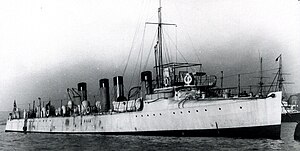Shirakumo-class destroyer

Japanese destroyer Shirakumo during commissioning, England, 1902
|
|
| Class overview | |
|---|---|
| Name: | Shirakumo class |
| Builders: | John I. Thornycroft & Company Chiswick, England |
| Operators: |
|
| Preceded by: | Akatsuki class |
| Succeeded by: | Harusame class |
| In commission: | February 1902 – April 1923 |
| Completed: | 2 |
| Retired: | 2 |
| General characteristics | |
| Type: | Destroyer |
| Displacement: | 322 tons normal, 428 tons full load |
| Length: |
|
| Beam: | 6.34 m (20 ft 10 in) |
| Draught: | 1.89 m (6 ft 2 in) |
| Propulsion: | 2-shaft reciprocating engines, 4 boilers, engine output 7,000 hp (5,200 kW) |
| Speed: | 31 knots (57 km/h; 36 mph) |
| Complement: | 62 |
| Armament: |
|
The Shirakumo-class destroyers (白雲型駆逐艦 Shirakumogata kuchikukan?) was a class of two torpedo boat destroyers (TBDs) of the Imperial Japanese Navy.
The Shirakumo-class destroyers were ordered under the 1900 fiscal budget as a follow-on to the earlier Murakumo class. Both were ordered from the yard of John I. Thornycroft & Company in Chiswick, England. These were amongst the last destroyers purchased by Japan overseas; most subsequent destroyers in the Imperial Japanese Navy were either prizes of war, or were built in Japan.
Substantially identical to the previous Murakumo class, the Shirakumo class was slightly larger in displacement with a slightly more powerful engine. The main difference externally between the vessels was in the design of their rudders. With the previous class, the rudder was semi-balanced, and had a portion exposed above the waterline. This made the vessel vulnerable to disablement by stray gunfire.
The design of the Shirakumo-class destroyers was similar to that of the two-stack torpedo boat destroyers produced by Thornycroft for the Royal Navy; (from 1913 these were grouped as the D class), also known as the “Thirty Knotters”. Both vessels had a flush deck design with a distinctive "turtleback" forecastle that was intended to clear water from the bow during high speed navigation, but was poorly designed for high waves or bad weather. The bridge and forward gun platform were barely raised above the bow, resulting in a wet conning position. More than half of the small hull was occupied by the boilers and the engine room. With fuel and weaponry, there was little space left for crew quarters.
...
Wikipedia
